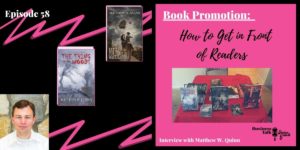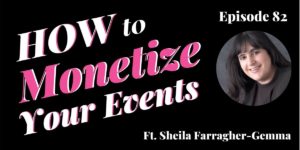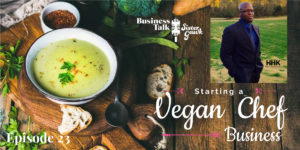Author, Cedar Sanderson, tells us all about how she uses beta readers, writers groups, and more to make sure her books are fun to read! She has a ton of experience working in different genres, and gives us a run down on how valuable the cover is for making sure people will read your book. If you’ve ever considered writing a book, this series is a great fit for you!
Welcome to Business Talk Sister Bekkah. I’m Bekkah! And I’m Ruthie! And today we are continuing our three-part series on authorship today’s episode title is “How to Write a Book People Will Read.” With us today we have Cedar Sanderson! Thanks so much for being with us today!
Cedar: Thank you for having me! I’m really excited to do this with you.
Bekkah: Well, we are definitely looking forward to it especially because of all of our conversations we’ve had with you already. Can you tell us first what do you do?
Cedar: I do a lot of things but the thing that’s relevant to this is I write books. I’ve written a lot of books. I have nine novels out now and a couple of dozen short stories, two children’s books, and a couple of coloring books.
How Did You Become an Author?
Ruthie: Wow! Cool! Okay, so tell us why did you start doing it?
Cedar: I started writing – gosh I started writing professionally a decade ago! But I had been writing before that because I tend to find it easier to express myself in the written word than I do speaking. About two decades ago I also got involved in public performance. Now I’m really comfortable with both speaking and writing which is interesting but I started writing fiction because it’s an interesting way to explore. I tend to be very character-based. I like to explore people and interact.
How Do You Do Your Work as an Author?
Bekkah: Okay, so how do you do this then?
Cedar: I’m a “pantser” which means that I fly by the seat of my pants. *all laugh* A lot of people need to outline and set up a plot so they can kind of keep their book on the rails. I’ve always liked what Agatha Christie said about what people like me do and evidently, she did too. She said, “It’s like driving down a road in heavy fog and you never know when the next turn is coming,” and I’ve had a few stories go off the rails and plunge down into a deep ravine and kind of come to a crashing halt but the fun part of it for me and this is what my brain needs is. It needs that little mystery of what’s going to happen next because if I try to outline a story my brain’s like, “Okay, you’ve told the story we’re done now,” and I’m like but, but a hundred thousand words! And my brain’s like, “Nope, we’re done.” *all laugh* So I’m a pantser which means I kind of have to figure it out as I’m going.
Ruthie: I feel like I can relate to that to some degree. Maybe a lot degree, but not so much in writing. I always tell my mom that being a forgetful person is like living in constant surprise. You just throw yourself little surprise parties every day. You’re like, “Oh! I scheduled that!? Wow!”
Cedar: There you go!
How Do You Gain Inspiration to Write a Book?
Bekkah: Our next question is how do you gain inspiration to write a book?
Cedar: Well, let’s see. That happened in a lot of different ways. I think my best-selling book which is Pixie Noir and which was born out of my really good friend at the time had challenged me to read some books that were kind of out of my comfort zone. I read a bunch of Mickey Spillane and then some Dashiell Hammett and Raymond Chandler. Those are all really famous Noir – gritty detection kind of stories. Then I wanted to make him laugh and return so I started writing this story that was a mashup of fantasy tropes and Noir detective fiction. I succeeded in making him laugh and a whole bunch of other people too because that book really took off and sold far better than I ever thought it would.
What Is a Noir?
Ruthie: What is a Noir?
Cedar: “Noir” is the French word for “black”. They’re very dark and it comes from film Noir which literally was filmed and they were very dark, the lighting is dim. There’s a lot of rain. There’s a lot of debate about what Noir really is but it’s almost like the anti-hero. The guy that’s been knocked down and kicked in the teeth but he just keeps getting up and charging forward anyway into the face of evil even though he has absolutely no hope of succeeding and winning because he can’t stop. He just has to do the right thing and that’s what Noir is for me at least but there’s a lot of gritty and bleak. But for me, Noir always has that kernel of heroism and hope.
How Do You Test Out a Book You Wrote to See if People Will Enjoy It?
Ruthie: You said that you made someone laugh with the Noir that you wrote. How do you test out what people will enjoy? You said you talked with that one person but what were some other ways that you tested?
Cedar: I actually do a couple of different things now. I mean, that was very early in my reading career. When I first started I was part of a writing group and I would send a chapter or a short story out by email. I’ve never had an in-person writing group, but I’d send it out by email then I would get critiques back or responses. Now what I do is I have a blog and my blog is very often non-fiction essays and a lot of recipes because I’m very comfortable cooking. It’s my happy place but I also put up snippets and bits of fiction there. Then people in the comments tell me if they liked it or they didn’t. They’ll give me thoughts on how they felt when they were reading it and that helps. The other thing I have for actual finished pieces is a group of what’s called “beta readers”. I send it out to them and they read and get back to me with specific input. Usually, my question when I send up a manuscript in the email is, “Is this a story or a cabbage?” *all laugh* I have a couple of people I use as “alpha readers” as well. When I’m super stuck I’ll be like, “Can you, please come read this and tell me if I’ve crashed down into that ravine and lost in the fog?” So I have a bunch of different ways I can get feedback and then of course once it’s published there are reviews. They say you should never read your reviews but I do anyway.
Bekkah: Does that help you or hurt you?
Cedar: Well, a little bit of both because sometimes I’ll get a review and I’ll be like, “I don’t think they read the book I wrote but, okay.” A lot of times I also get some really great reviews that are just like, “They really got it!” It’s a little humbling sometimes to get a review and have someone tell you that you really moved them or they thought this was amazing and you’re just like, “Gosh! I don’t know if I deserve that!”
Bekkah: How do you pinpoint a genre if you have the urge to write. Do you have to write about every sort of topic in different sections or can you clump them into one?
How to Select the Genre For a Book You Wrote
Cedar: Genre is this really interesting thing. I spent some time as a librarian. I was technically a children’s librarian but it was a very small library so we all did a bunch of everything and genre is one of those things that was kind of created by librarians and marketers so that they would know where to put a book on the shelf.
Ruthie: Bekkah loves librarians and marketing! So there you go!
Cedar: Yeah! So do I! Genre is one of those things that I don’t think about when I’m writing usually. I will occasionally have a book that I’m writing and I’ll be telling people when I talk about it that this doesn’t fit in a genre and it’s going to be a problem. Actually, my good friend Tom Knighton came up with a genre definition after I expressed some frustration that urban fantasy is the typical contemporary fantasy that’s set in modern times, and obviously with the word “urban” in there, they’re in cities. Well, I write contemporary fantasy but there’s no urban! So my friend Tom Knighton after reading one of my books Possum Creek Massacre informed me that what I’m writing is “banjo fantasy”! *all laugh* It was set in the Appalachians. There’s magic, there’s police procedural because I have a criminal justice background. Genre tends to be something I think about after I’m done because then I have to go in when I’m getting ready to publish and I have to assign it a genre. That leads into a lot of things. Cover design signals genre. You have to have the right cover to tell readers what’s inside the book and when you’re setting up your marketing you need to know genres you’re marketing to the right people that are looking for this book.
Does Cover Art Vary by Genre?
Bekkah: How does cover art vary by genre?
Cedar: That gets to be a really broad topic because a romance cover is not the same thing as a western cover. It’s not the same thing as military science fiction or military fiction for that matter. I do some cover design. When I first started publishing I didn’t have money to hire someone to do it. I did have some graphic design background and, yes, I do everything except I can’t knit! *all laugh*
Ruthie: It sounds like you do everything! Honestly, you just keep mentioning all these different things that you’ve done and I’m like, “Oh my word!” So sorry you can’t knit.
Cedar: I can’t knit. I’ve never been able to teach myself how to cast on but that’s kind of the genesis of this is. I was homeschooled. I’m an autodidact and if I need to do something I generally teach myself how to do it. Graphic design and cover art are not exactly the same thing cover it as a very specific subset of it. I did take a Dean Wesley Smith workshop and I worked with a lot of people over the years talking about what fits where. Let’s pick one like let’s say urban fantasy cover. If I’m designing an urban fantasy cover there are some elements it needs to have on it. The typography needs to be right. That’s one of those dancing targets that changes so you have to keep up with the genre expectations. There needs to be a central figure probably human. If you put in a central figure and an animal then it signals paranormal romance. You don’t want that if you’re doing straight urban fantasy because they’re not the same thing.
You want to have some kind of a magical element usually what I call a “glowy thing.” If it glows it’s magic. Bright green, bright blue, pink, it depends. I’ve done some covers for Amy Gibbons. She is this sweet, southern belle. She writes that kind of character so I tend to go with pinks and oranges for her because they fit her characters. But generally speaking, if I’m going to design a cover, the first thing I try to do is figure out from the author what the subgenre is. I narrow it down past even genre to specific sub-genre. Then I hop on Amazon and I see what the top 100 bestsellers in that sub-genre are. Not the free books in that sub-genre but the best-sellers. I kind of look at those and I look at what elements are being repeated and then I can go and say, “Okay, we’re going to need to do this bit and this bit and this bit” and pull it all together into a cohesive whole because a book cover is more about signaling genre. What’s in the book is almost never an exact replica of a scene from the book.
As an Author, How Important Is the Cover to Getting Sales?
Bekkah: Would you say that the cover is probably one of the most important things when deciding if a book is going to sell or not or is there more to that?
Cedar: I would say that the book cover is really important. People say that they don’t look at the book covers and they fib. People do judge a book by its cover. It gets even more difficult when you think in terms of most sales these days are done on Amazon and most readers encounter book covers in a thumbnail size. It’s this teeny, tiny, little thing. It’s often on their phone or their browser so you have to design for that. It has to really pop but it can’t look too different from the other books in that genre so the reader gets confused and they’re like, “Is that really what I want?” It’s a challenge.
How Is Writing a Children’s Book Different Than Other Genres?
Ruthie: How has writing children’s books been different than other genres that you’ve written in?
Cedar: Oh! It’s hugely different! I’ve been doing art, that was part of what I did as a performer. I did family entertainment and I was a face painter, a balloon twister, did a little bit of comedy magic, but mostly the face painting led me to want to do it on paper. So I started doing art and I’ve been doing art almost daily for six years now. My art tends to be cute. I can’t help it. It just comes out cute. I’ve tried doing fierce. It doesn’t work. The coloring books I did are The Adventures of Inktale the Dragon. For years people were telling me, “You have to write a children’s book with this little character you have pictures of him doing these things!” and I’m like, “Writing a children’s book is so different from writing a novel!” I can write a hundred thousand words and have plot and character interactions but a children’s book is just a few hundred words and they have to be the right words for the right reading level! And I kind of vapor locked. I was trying to talk my mom into writing the story because she’s a really good writer.
I was going to do the illustrations and then this last year I came up with this idea that I had to do a children’s book for my sister. Now my sister is severely autistic and mentally is about four. She has a joke about being a cute moose and she’ll hold her hands up to her head like a be like antlers. So I decided I was going to do a cute moose rhyming book for her Christmas present and that turned into my first children’s book. It came out super cute and a lot of people really loved it so when I was approached by a friend who had written a story and wanted me to do the illustrations for it I was like, “Yeah! I can do this!” There’s going to be a couple more coming out this year, too.
Bekkah: Oh, awesome! Okay, so far my running list is librarian, criminal justice background, balloon twister, face painter –
Ruthie: Illustrator, author, sister, and daughter! The list goes on and on!
Bekkah: When you’re thinking about promoting and writing for your audience to say because we just talked about how it’s a fine line between are they going to read this versus not read it because of being right in the genre. In the actual story that you’re writing, has your process changed as you’ve learned from new books to see what works a lot better for people or anything like that?
How Have Your Processes Changed Over Time In Being a Writer?
Cedar: I don’t really read books on writing. That’s never been how I’ve learned how to write. What I read books for is I read books that I enjoy. I’ve tried to then study them and be like, “Okay, I really enjoyed this. What was it that pulled me into it?” Honestly, it’s made it really difficult sometimes because I love reading. I’ve read since I was like four years old and I used to read enough that my mom would tell me I was reading too much when I was a teenager. Not getting chores on usually, but now as a writer, if I go in and I start reading a book that isn’t quite what it should be and that’s kind of how my very first novel wound up happening. My daughter got me to read a book that she really loved and I was like, “Wow! I could do this!”
Ruthie: When we were talking originally you had said that you would send her chapters of your book while she was at summer camp every day and I thought that was the coolest thing ever! I was like, “Wow! Go, mom!” I love that.
Cedar: It was the first time she’d been away from home for very long. She had me read this book just a couple of months before so I started writing what would later become the novel Vulcan’s Kittens. Basically, how I describe it as I threw the world myths into the blender and came up with *all laugh* At the time, this was very, very early I didn’t want to write fantasy. I wanted to write science fiction. I’ve always wanted to be a scientist. So I was like, “I have to come up with a scientific basis for the world myths,” and I did. So, technically, that book’s genre would be science fantasy. I know she came back from summer camp, started school, and came home with a sheet of paper one day and was like, “Mom, my teacher was telling me about NaNoWriMo [National Novel Writing Month]. Can you do this with Vulcan’s Kittens and make it into a full novel?”
How Do You Pick The Title For Your Books?
Ruthie: Now did you come up with your title for that? How do you pick your titles for books, Vulcan’s Kittens, and any other titles that you’ve written?
Cedar: Well, I knew if I used Hephaestus most people wouldn’t know what I was talking about so I went with his other name of Vulcan the god of volcanoes and fire and black-smithery. In the book I actually nicknamed him and he’s Grandpa Heff. I shortened Hephaestus to half but Vulcan’s Kittens, I knew it was going to be catchy. What I hadn’t thought through when I titled that book was that you would get wind up with people wondering if it was Star Trek fan fiction. Which it is totally not that kind of Vulcan with pointy ears. It has kittens. It has a litter of demi-god kittens that the main character winds up having to take care of and protect. That’s where the kittens came from because my daughter was and is all about cats. That was for her.
Ruthie: That’s so cool. I love that. Well, we have so many other things that we could ask you and pick your brain about but we are running out of time.
Bekkah: Tell us where people can find you.
Cedar: People can find me at my website and that’s cedarwrites.com and you can find me on Amazon under Cedar Sanderson I do have a pen name Lalanya Begley and that is because I knew if I wrote a romance novel my fans of science fiction and fantasy would go, “Ooh! Cooties!” So I published the romance novella. It’s less than 40,000 words but that one’s out under Lilania Begley.
If you think you know someone who will enjoy this podcast, share it with a friend!




